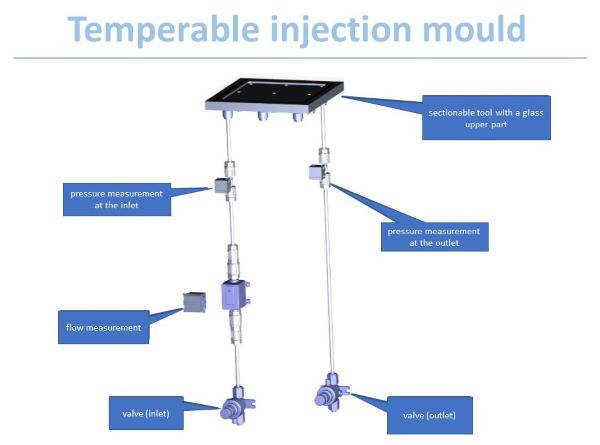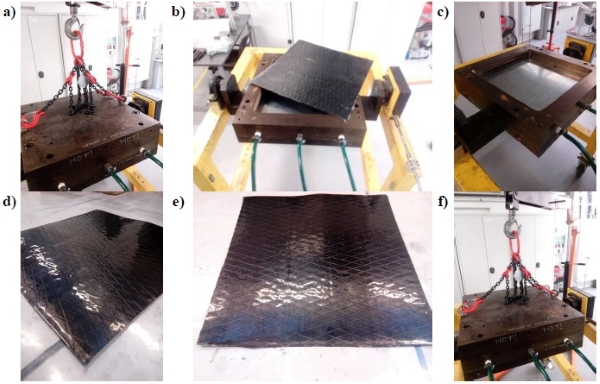Development of flame retarded polymer composites for engineering applications
Prof. Dr. Andrea Toldy
Dr. Gábor Szebényi
Dr. Péter Tamás-Bényei
Dr. Ákos Pomázi
Project summary
Nowadays in field of engineering applications the importance of fibre reinforced polymer composites as well as carbon fibre reinforced epoxy resins significantly growing due to their beneficial properties. However, the flammable polymer matrix of epoxy resin composites hinders their use in many high-tech applications. The aim of current research is the development of high-performance flame retarded composites for engineering applications (public transportation and different containers). Potential application of reactive and of additive flame retardants will be analysed, moreover optimization of manufacturing technology (hand lamination accomplished by hot-pressing method, RTM, VARTM) to avoid segregation and inhomogeneous dispersion of solid and liquid flame retardants will be carries out. Influence of reinforcement will be investigated on flame retardant dispersion as well.
Project results


Project-related publications
- Forintos N., Sarkadi T., Boros Cs. O., Czigány T.: Multifunctional carbon fiber sensors: The effect of anisotropic electrical conductivity. IEEE Sensors Journal, 21, 8960-8968 (2021) 10.1109/JSEN.2021.3053125 IF=4.325 Q1
- Forintos N., Sarkadi T., Czigány T.: Electric resistance measurement–based structural health monitoring with multifunctional carbon fibers: Predicting, sensing, and measuring overload. Composites Communications, 28, 100913/1-100913/4 (2021) 10.1016/j.coco.2021.100913 IF=7.685 Q1
- Pomázi Á., Toldy A.: Development of fire retardant epoxy-based gelcoats for carbon fibre reinforced epoxy resin composites. Progress in Organic Coatings , 151, 106015/1-106015/12 (2021) 10.1016/j.porgcoat.2020.106015 IF=6.206 D1
- Vermes B., Czigány T.: Non-conventional deformations: Materials and actuation. Materials, 13, 1383/1-1383/26 (2020) 10.3390/ma13061383 IF=3.623 Q1
- Vermes B., Czigány T.: Alakváltó kompozitok tervezése és gyártása autoklávval. Polimerek, 6, 895-899 (2020)
- Toldy A., Pomázi Á., Szolnoki B.: The effect of manufacturing technologies on the flame retardancy of carbon fibre reinforced epoxy resin composites. Polymer Degradation and Stability, 174, 109094/1-109094/10 (2020) 10.1016/j.polymdegradstab.2020.109094 IF=5.03 Q1
- Hegedűs G., Czigány T.: State monitoring of polymer composites with glass optical fibre and with equipment used in telecommunication. Acta Materialia Transylvanica, 3, 1-9 (2020) 10.33924/amt-2020-01-01
- Hegedűs G., Sarkadi T., Czigány T.: Self-sensing composite: Reinforcing fiberglass bundle for damage detection. Composites Part A: Applied Science and Manufacturing, 131, 105804/1-105804/7 (2020) 10.1016/j.compositesa.2020.105804 IF=7.664 D1
- Forintos N., Czigány T.: Multifunctional carbon fiber reinforced polymer composite structures: Reinforcing and sensing. in '6th International Conference on Sensors and Electronic Instrumentation Advances Porto, Portugália. 2020.09.23-2020.09.25.,162-166 (2020)
- Forintos N., Czigány T.: Reinforcing carbon fibers as sensors: The effect of temperature and humidity. Composites Part A: Applied Science and Manufacturing, 131, 105819/1-105819/5 (2020) 10.1016/j.compositesa.2020.105819 IF=7.664 D1
- Toldy A., Szebényi G., Molnár K., Tóth L. F., Magyar B., Hliva V., Czigány T., Szolnoki B.: The effect of multilevel carbon reinforcements on the fire performance, conductivity, and mechanical properties of epoxy composites. Polymers, 11(2), 303/1-303/13 (2019) 10.3390/polym11020303 IF=3.426 Q1
- Vas L. M., Kocsis Z., Czigány T., Tamás P., Romhány G.: Novel evaluation method of acoustic emission data based on statistical fiber bundle cells. Journal of Composite Materials, 53, 2429-2446 (2019) 10.1177/0021998319826666 IF=1.972 Q3
- Pomázi Á., Toldy A.: Effect of flame retardant filtration on the fire performance of carbon fibre reinforced epoxy composites made by resin transfer moulding. in 'International Conference on Composite Materials (ICCM22) Melbourne, Australia. 2019.08.11-2019.08.16.,1-12 (2019)
- Forintos N., Czigány T.: Multifunctional application of carbon fiber reinforced polymer composites: electrical properties of the reinforcing carbon fibers – a short review. Composites Part B: Engineering, 162, 331-343 (2019) 10.1016/j.compositesb.2018.10.098 IF=7.635 D1
- Pomázi Á., Toldy A.: Multifunctional Gelcoats for Fiber Reinforced Composites. Coatings, 9(3), 9030173/1-9030173/23 (2019) 10.3390/coatings9030173 IF=2.436 Q2
- Hegedűs G., Sarkadi T., Czigány T.: Multifunctional composite: Reinforcing fibreglass bundle for deformation self-sensing. Composites Science and Technology, 180, 78-85 (2019) 10.1016/j.compscitech.2019.05.018 IF=7.094 D1
- Tamás-Bényei P., Bitay E., Kishi H., Matsuda S., Czigány T.: Toughening of Epoxy Resin: The Effect of Water Jet Milling on Worn Tire Rubber Particles. Polymers, 11, 529/1-529/11 (2019) 10.3390/polym11030529 IF=3.426 Q1
- Szolnoki B., Toldy A., Marosi Gy.: Effect of Phosphorus Flame Retardants on the Flammability of Sugar-based Bioepoxy Resin. Phosphorus Sulfur and Silicon and the Related Elements, , 1539855/1-1539855/4 (2019) 10.1080/10426507.2018.1539855 IF=1.046 Q4
- Hegedűs G., Czigány T.: Sérülés helyének megállapítása kompozit szerkezetekben az üveg erősítőanyag felhasználásával. in 'XXVII. Nemzetközi Gépészeti Konferencia OGÉT 2019 Nagyvárad. 2019.04.25-2019.04.28.,189-192 (2019)
- Vermes B., Czigány T.: Layup optimization and ways to improve the manufacturability of coupled composites. in 'International Conference on Composite Materials (ICCM22) Melbourne, Australia. 2019.08.11-2019.08.16,7 (2019)
- Hegedűs G., Sarkadi T., Czigány T.: Self-sensing polymer composite: white-light-illuminated reinforcing fibreglass bundle for deformation monitoring. Sensors, 19, 1745/1-1745/8 (2019) 10.3390/s19071745 IF=3.275 Q1
- Toldy A., Pomázi Á., Szolnoki B.: The effect of manufacturing technologies on the flame retardancy of carbon fibre reinforced epoxy resin composites. in 'European Meeting on Fire Retardancy and Protection of Materials (FRPM19) Turku, Finland. 2019.06.26-28.,2 (2019)
- Pomázi Á., Toldy A.: Égésgátolt glicerin alapú epoxigyanta kompozitok fejlesztése mérnöki alkalmazásokhoz. Polimerek, 4(2), 59-64 (2018)
- Marosi Gy., Hirsch E., Bocz K., Toldy A., Szolnoki B., Bodzay B., Csontos I., Farkas A., Balogh A., Démuth B., Nagy Z., Pataki H.: Pharmaceutical and macromolecular technologies in the spirit of industry 4.0. Periodica Polytechnica-Chemical Engineering, 64, 4 (2018) 10.3311/PPch.12870 IF=1.382 Q3
- Hegedűs G., Czigány T.: Polimer kompozit termékek komplexitását kihasználó üvegszálas érzékelő csatlakozójának fejlesztése. in 'OGÉT 2018: XXVI. Nemzetközi Gépészeti Konferencia Marosvásárhely, Románia. 2018.04.26-2018.04.29.,179-182 (2018)
- Pomázi Á., Toldy A., Szolnoki B.: Flame Retardancy of Low-Viscosity Epoxy Resins and Their Carbon Fibre Reinforced Composites via a Combined Solid and Gas Phase Mechanism. Polymers, 10, 1081/1-1081/13 (2018) doi:10.3390/polym10101081 IF=3.164 Q1
- Toldy A.: Editorial corner - a personal view Flame retardancy of carbon fibre reinforced composites.
- Vermes B., Czigány T.: Kompozitok alakváltásának lehetőségei. Gép, 69, 51-54 (2018)
- Hegedűs G., Czigány T.: Developing a glass fibre sensor for polymer technology applications. IOP Conference Series: Materials Science and Engineering, 426, 012015/1-012015/1-4 (2018) 10.1088/1757-899X/426/1/012015
- Toldy A., Niedermann P., Pomazi A., Marosi G., Szolnoki B.: Flame Retardancy of Carbon Fibre Reinforced Sorbitol Based Bioepoxy Composites with Phosphorus-Containing Additives. Materials, 10, 467/1-467/ (2017) 10.3390/ma10050467 IF=2.467 Q2
- Péter B., Hegedűs G., Czigány T.: T-RTM eljárással gyártott alkatrészek gyártási folyamatának kihívásai, különös tekintettel az erősítőanyagok kezelésére. Gép, 68, 37-42 (2017)
- Hegedűs G., Czigány T.: Optikai szálak alkalmazása polimer anyagvizsgálatokhoz. in 'OGÉT 2017: XXV. Nemzetközi Gépészeti Konferencia Kolozsvár, Románia. 2017.04.27-2017.04.30.,175-178 (2017)
- Hegedűs G., Sarkadi T., Czigány T.: Analysis of the light transmission ability of reinforcing glass fibers used in polymer composites. Materials, 10(6), 637/1-9 (2017) 10.3390/ma10060637 IF=2.467 Q2
- Pomazi A., Toldy A.: Particle Distribution of Solid Flame Retardants in Infusion Moulded Composites. Polymers, 9, 250/1-250/ (2017) 10.3390/polym9070250 IF=2.935 Q1
- Czigány T., Forintos N., Hegedűs G.: Health monitoring of high-performance polymer composites with multifunctional fibers. in 'ICCM21 Xi'an, Kína. 2017.08.20-2017.08.25.,8 (2017)






